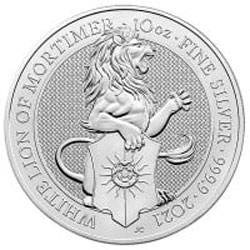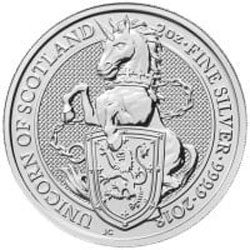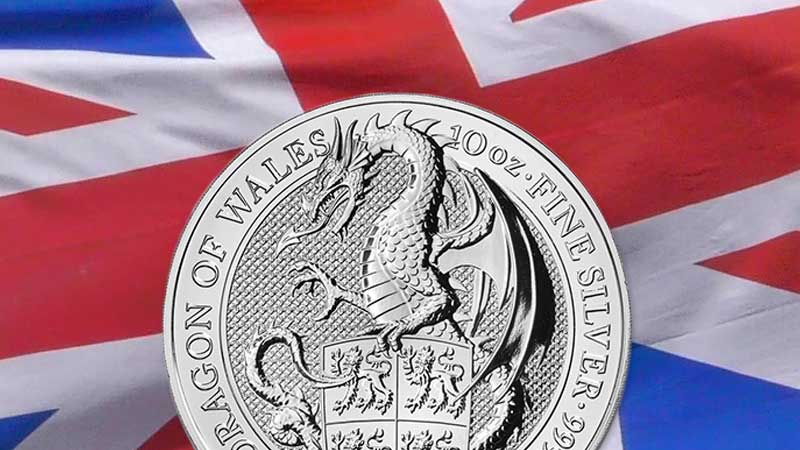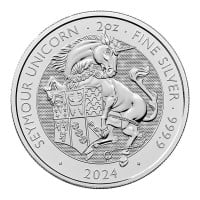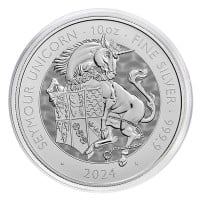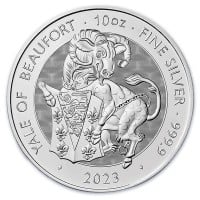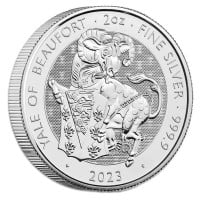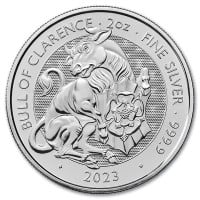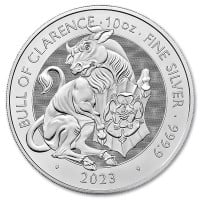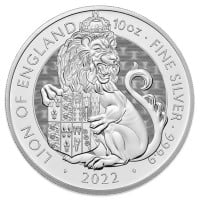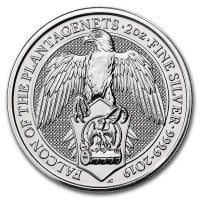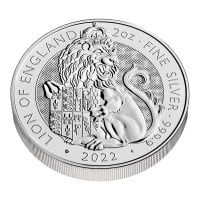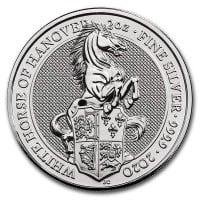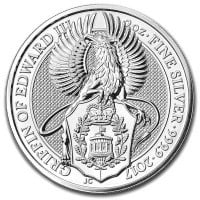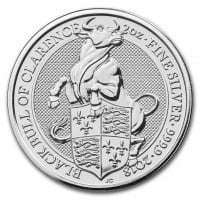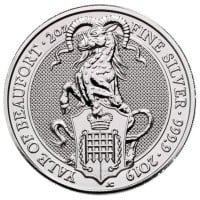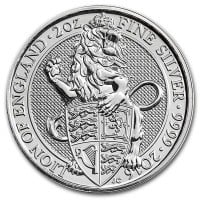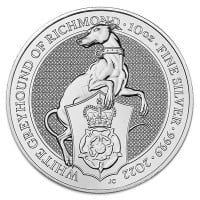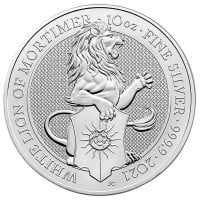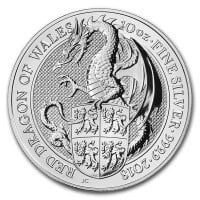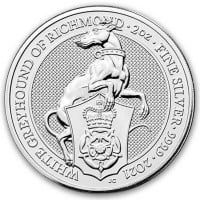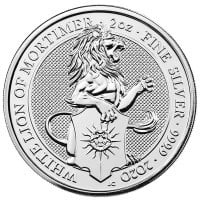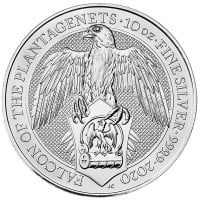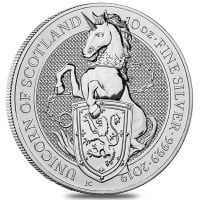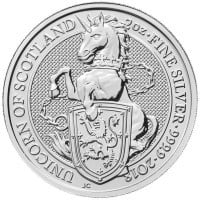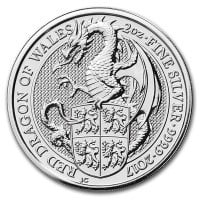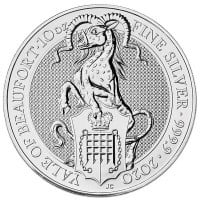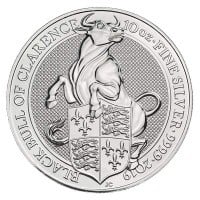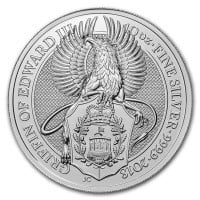The Queen’s Beasts are a series of 10 coins made by the United Kingdom’s Royal Mint. The beasts are stylized versions of the Queen’s Beasts statues present at Queen Elizabeth II’s coronation in 1952. Each of the beasts represents Her Majesty’s royal ancestry and was taken from the coat of arms, or badges, of some of the Queen’s key predecessors.
The series was introduced in 2016 and the coins were made in both silver and gold. Platinum coins were added to the program in 2017. Proof and bullion versions are available, ranging from ¼ oz to 1 kg. The face value ranges from £2 for the smallest coins to £1,000 for the largest. This series also prominently features the United Kingdom’s first ever 2 oz silver bullion coin.
All coins are to be designed by the famous engraver Jody Clark. Read on for a more in-depth look at the Queen’s Beasts and whether they are safe to invest in.
History of The Queen's Beasts Silver Coins
The first coin in the series, the Lion of England was released in March 2016, though it was designed a year earlier. The initial run sold out quickly, with the follow-up being released in June 2016.
The first proof coins were struck in late 2016 and the platinum Queen’s Beasts coins were unveiled the following year. A small run of brilliant uncirculated coins of cupro-nickel and 1 oz (£5 face value) was also struck.
Size, Face Value, and Weight of The Queen's Beasts
The gold and silver coins are of an exceptional .9999 fineness. The platinum bullion coins come with .9995 fineness.
The gold bullion coins are available in ¼ oz (£5 face value, 22 mm diameter) and 1 oz (£100 face value, 32.69 mm diameter) sizes. The gold-proof coins come in 1 kg (£1,000 face value, 100 mm diameter), 5 oz (£500 face value, 50mm diameter), 1 oz (£100 face value, 32.69 mm diameter), and ¼ oz (£25 face value, 22 mm diameter) sizes.
The silver bullion coins are available in 10 oz (£10 face value, 89 mm diameter) and 2 oz (£5 face value, 38.61 mm diameter) variants. The silver proof coins are 1 kg (£500 face value, 100 mm diameter), 10 oz (£10 face value, 65 mm diameter), 5 oz (£10 face value, 38.61 mm diameter), and 1 oz (£2 face value, 38.61 mm diameter).
The platinum bullion coins are available only as a 1 oz coin with a £100 face value and 32.69 mm diameter.
As for the packaging, the Royal Mint ships the 2 oz silver coins in tubes of 10 with 20 tubes in a box. The 1 oz gold coins are packaged in tubes of 10, with 10 tubes (100 coins) in a box. The larger coins (5 oz, 10 oz, kilo) are individually sealed in clear plastic. Proof coins are individually packed in mint boxes with certificates of authenticity.
The Queen's Beasts Design
The obverse side of the Queen’s Beasts coins is adorned with the portrait of Queen Elizabeth II (her fifth definitive coinage portrait). Around the portrait, the coins feature the following text: ELIZABETH II ·D·G·REG·F·D· (2/5/10/25/100/500/1000) POUNDS. The abbreviation stands for “Dei Gratia Regina Fidei Defensor” which translates to “Grace of God, Queen, Defender of the Faith.”
This portrait of Queen Elizabeth II can commonly be seen on various pound sterling coins.
The reverse side has a portrait of the corresponding beast with a shield, surrounded by the beast’s name, coin’s weight in ounces, material, fineness, and year of issuance. The designer’s initials can be found right below the shield. On proof coins, the beasts are slightly different and Mr. Clark’s initials are inscribed on the shield.
The Beasts
The Lion of England
The first beast to be featured on the Queen’s Beasts coins is the Lion of England, the supporter of the Royal Arms of England (and the United Kingdom) since Edward IV. The shield depicts the Arms of the United Kingdom as they’ve been since the coronation of Queen Victoria (1837).
The Griffin of Edward III
The Griffin of Edward III is the second beast. It debuted in November 2016 and depicts the griffin featured on the private seal of King Edward III.
The Red Dragon of Wales
The Red Dragon of Wales is featured on the next coin. It was released in March 2017 and represents the mythical red dragon traditionally associated with the rulers of Wales. Henry VIII also used it on his ships.
The Unicorn of Scotland
The Unicorn of Scotland coin was the fourth in the series. It depicts the chained unicorn with a crown around its neck. The shield represents the Scottish Royal Arms of James VI of Scotland who later became James I of England.
The Black Bull of Clarence
The Black Bull of Clarence was the fifth coin in the series, introduced in March 2018. The black bull was associated with Edward IV, Richard III, and all monarchs from the houses of Tudor and Lancaster.
The Falcon of the Plantagenets
The Falcon of the Plantagenets was the sixth and, at the time of this writing, the most recent addition to the series. It was released in September 2018. Edward III used it as his badge, passing it on to Edward IV who used it as his badge.
Four additional coins are to be released before the series is concluded. They include the White Lion of Mortimer (the white lion is uncrowned unlike the Lion of England), the Yale of Beaufort (associated with Henry VII and his mother, Lady Margaret Beaufort), the White Horse of Hanover (represents George I, who was the Elector of Hanover before ascending to the British throne), and the White Greyhound of Richmond (badge of John of Gaunt which represents the union of the houses of Lancaster and York).
Investing in Queen’s Beasts Silver
The Queen’s Beasts series launched in 2016 and has quickly become quite popular on both sides of the pond, especially in the UK. Each release tends to sell quickly, and values for some out-of-production coins have risen
The silver, gold, and platinum coins are being struck in bullion purity metals, guaranteed by the Royal Mint. The intricate and historically significant designs on the coins help to ensure the series will remain popular in the years to come, especially among collectors. Investors, on the other side, might find the potential for higher coin premiums over time even more attractive than the design.
Conclusion
The Queen’s Beasts coins, whether silver, gold, or platinum, represent a sound and safe investment. The bullion strike coins offer an affordable premium for early buyers, with the potential for that premium to rise based on the limited issuance. Moreover, the beasts offer an attractive design and engaging story, which should support demand over the years to come.
Apart from their investment value, these coins are an interesting addition to any collector’s portfolio. The coins featuring the ten beasts attending the coronation of Queen Elizabeth II will add much to any metal investor’s holding.

